I thought that the Graphic Science piece on the last page of the latest Scientific American magazine ( Dec. 2011 issue) was pretty interesting. I scanned the image in from a paper-based copy of the magazine, and then shortly afterwards realized that the graphic was also available, in a superior interactive version, on the SciAm website. Someone remind me why I buy magazines again…
I think the study suffers from using a sample size (600) that is much too small, and much of what we see can probably be contributed to coincidence more than anything. That being said, I don’t think you can look past the obvious connection between people interested in both technology and education.
It’s funny, because traditionally education is an under-funded sector that often lags behind business, media, and science when it comes to adopting new technologies. What can account for the strong link between technology and education as shown above? Are a disproportionately large number of teachers using bit.ly? Are we seeing a grassroots movement of education reform, with technologically-savvy teachers using Twitter to network and collaborate? Are private educational institutions with more funds than their public counterparts more likely to be tightly linked with technology?
In reality, this is simply a small-scale study that yields more questions than answers. It’s not clearly explained how the sites were categorized, and we can’t hope to make any conclusions from it. But as Marshall McLuhan showed, it’s often more fun and instructive to talk about the questions than the answers.
In describing the wheel, language, the alphabet, the written and printed word, the telescope, Newtonian mechanics, the radio, and the television as technologies, McLuhan shows that studying human cultural evolution is essentially a study of the development of our technologies, which we use to learn about and adapt to our environments. He points out in 1969 that technology is much more than just a tool, and that the “the total-field awareness engendered by electronic media is enabling us — indeed, compelling us — to grope toward a consciousness of the unconscious, toward a realization that technology is an extension of our own bodies. We live in the first age when change occurs sufficiently rapidly to make such pattern recognition possible for society at large.”
If education really is life itself, as John Dewey said, then technology as defined by McLuhan is certainly forever intertwined with education. The evolution of our technologies has really been the story of the efficiency of information and the literacy we’ve developed to transmit it. Language, numbers, the alphabet, the printed word, and now, media such as Twitter and text messages have increasingly allowed us to transmit more information, while saying and using less. Education is built upon literacy – of numbers, words, and ideas. The forms of literacy have always been evolving as new technologies create new media. From the spoken word to the written word, from the printed word to television, it’s always been the case that we must educate to keep up with the growth of new technology, while being careful to not entirely leave behind what we gained from the old. Of course in the 21st century, with the pace of change relentless, this is harder than ever, but it’s not impossible. All generations have thought their own present time had a pace of change that was relentless.
While far from conclusive, I think that this graphic hints at this inseparable relationship between education and technology, although in all honesty, the strong link is most likely simply due to a lot of nerdy teacher-folk who spend a lot of time on the internet. (I would know.)
